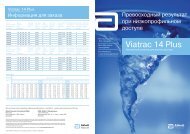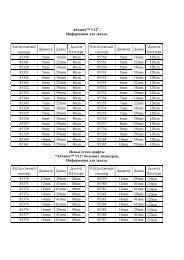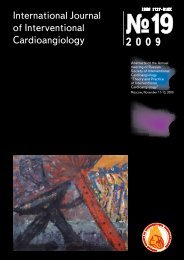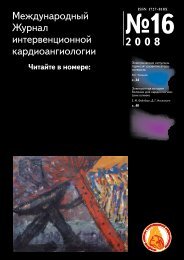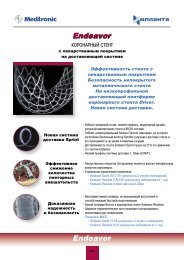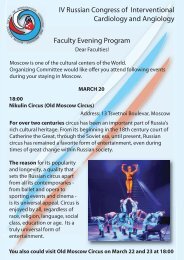Results of Coronary Stenting using the Stents with
Results of Coronary Stenting using the Stents with
Results of Coronary Stenting using the Stents with
Create successful ePaper yourself
Turn your PDF publications into a flip-book with our unique Google optimized e-Paper software.
Interventional cardiology<br />
<strong>the</strong> blood vessels, manifested as a response to dilatation.<br />
It occurs immediately after percutaneous transluminal<br />
coronary angioplasty (PTCA). Thrombosis is<br />
a consequence <strong>of</strong> endo<strong>the</strong>lial damage, rupture <strong>of</strong> <strong>the</strong><br />
intima and damage <strong>of</strong> <strong>the</strong> middle layer <strong>of</strong> a vessel.<br />
These damages lead to <strong>the</strong> accumulation <strong>of</strong> platelets<br />
and <strong>the</strong> formation <strong>of</strong> a thrombus. The accumulated<br />
platelets represent a source <strong>of</strong> attractants and mitogens<br />
for smooth muscle cells (SMC). Besides,<br />
platelet-derived growth factor (PDGF), released by<br />
endo<strong>the</strong>lial cells and macrophages, is considered<br />
as <strong>the</strong> main factor contributing to SMC migration. Inflammation<br />
plays an important role in restenosis, as<br />
leucocytes are found in <strong>the</strong> site <strong>of</strong> vascular damage<br />
early and in great amount (26). According to H<strong>of</strong>ma<br />
H. S., et al. (27), inflammation process plays a more<br />
important role in <strong>the</strong> healing <strong>of</strong> arterial wall after<br />
stenting, which can be explained by <strong>the</strong> presence <strong>of</strong><br />
a foreign body (stent) in <strong>the</strong> arterial lumen (28). An<br />
important role is also played by neointimal hyperplasia.<br />
In <strong>the</strong> involved vessel, <strong>the</strong> SMC enter into <strong>the</strong> proliferation<br />
phase and move to <strong>the</strong> intima through <strong>the</strong><br />
damaged internal elastic membrane. An important<br />
place in this process belongs to metalloproteinases.<br />
They continue to divide and to syn<strong>the</strong>size <strong>the</strong> extracellular<br />
matrix (ECM), which, In <strong>the</strong> end, forms <strong>the</strong><br />
volume <strong>of</strong> restenotic lesion. The components <strong>of</strong> ECM<br />
— hyaluronan, fibronectin, osteopontin and vitronectin<br />
— also contribute to SMC migration. Moreover,<br />
<strong>the</strong> reorganization <strong>of</strong> ECM, as well as its replacement<br />
<strong>with</strong> collagen can lead to <strong>the</strong> contraction <strong>of</strong> <strong>the</strong> vascular<br />
wall. The adventitial my<strong>of</strong>ibroblasts, playing an<br />
important role in intima supply <strong>with</strong> proliferative cell<br />
elements in restenosis, also divide and migrate in<br />
<strong>the</strong> neointima. The adventitial cells also participate<br />
in <strong>the</strong> process <strong>of</strong> vessel remodeling, as my<strong>of</strong>ibroblasts<br />
are able to syn<strong>the</strong>size collagen and lead to<br />
tissue contraction (26). Rogers and Edelman (29),<br />
Edelman and Rogers (30) have demonstrated that<br />
<strong>the</strong> damage and, as a consequence, <strong>the</strong> interruption<br />
<strong>of</strong> <strong>the</strong> integrity <strong>of</strong> <strong>the</strong> internal elastic membrane<br />
is <strong>of</strong> key importance for intimal hyperplasia during<br />
<strong>the</strong> development <strong>of</strong> in-stent stenosis. During stent<br />
implantation, after primary balloon-induced injury<br />
<strong>of</strong> <strong>the</strong> vascular wall <strong>with</strong> <strong>the</strong> rupture <strong>of</strong> internal elastic<br />
membrane, one assists at an intensive proliferation<br />
<strong>of</strong> <strong>the</strong> intima. Its degree is proportional to <strong>the</strong><br />
depth <strong>of</strong> stent insertion. Thus, it has been shown,<br />
that <strong>the</strong> hyperplasia <strong>of</strong> <strong>the</strong> intimal layer represents<br />
a response to an external impact (lumen dilatation<br />
<strong>with</strong> an inflated balloon and stent insertion) and is<br />
proportional to <strong>the</strong> degree <strong>of</strong> mechanical damage <strong>of</strong><br />
<strong>the</strong> vascular wall’s structures (29, 30). The feasibility<br />
<strong>of</strong> <strong>using</strong> stents as a reinforcing device became<br />
evident after experimental and clinical confirmation<br />
<strong>of</strong> an important role <strong>of</strong> early elastic recoil and negative<br />
remodeling <strong>of</strong> <strong>the</strong> vessels in <strong>the</strong> development<br />
<strong>of</strong> restenosis (31). Intravascular ultrasound (IVUS)<br />
allowed to understand that <strong>the</strong> late lumen loss and<br />
restenosis after PTCA are due not so much to intimal<br />
hyperplasia, as to negative remodeling <strong>of</strong> <strong>the</strong> vessel.<br />
Catala (32) has experimentally shown that <strong>the</strong> design<br />
and <strong>the</strong> material <strong>of</strong> stent produce a significant on <strong>the</strong><br />
probability <strong>of</strong> restenosis development. An ideal stent<br />
design should maximally limit smoot muscle cells<br />
migration to <strong>the</strong> surface <strong>of</strong> <strong>the</strong> intima (32). Similarly,<br />
Topaz and Vetrovek (28) came to <strong>the</strong> conclusion that<br />
more dense, uniform reinforcement <strong>of</strong> <strong>the</strong> arterial<br />
lumen contributes to more effective prevention <strong>of</strong><br />
neointimal growth.<br />
Today two different tactics are being used for <strong>the</strong><br />
fight against restenosis — it can be treated or prevented.<br />
The <strong>the</strong>rapeutic tactics is based on <strong>the</strong> use <strong>of</strong><br />
mechanical methods, while <strong>the</strong> prevention <strong>of</strong> in-stent<br />
stenosis formation is effectuated through <strong>the</strong> use <strong>of</strong><br />
pharmacological agents and new technologies <strong>of</strong><br />
stenting (including <strong>the</strong> use <strong>of</strong> new stents <strong>with</strong> antiproliferative<br />
properties) (33).<br />
A drug-eluting stent (DES) usually contains a<br />
metal base, a polymer layer <strong>with</strong> a drug absorbed<br />
into or mixed <strong>with</strong> this layer, sometimes — a protective<br />
polymer layer preventing early drug washing out,<br />
and <strong>the</strong> drug, as such.<br />
The pharmacological agent must be able to inhibit<br />
maximal amount <strong>of</strong> different components participating<br />
in complex process <strong>of</strong> restenosis (34, 35). All<br />
know anti-inflammatory and histochemical agents,<br />
immunomodulators, some antibiotics, as well as <strong>the</strong><br />
medications used in oncology for <strong>the</strong> decrease <strong>of</strong><br />
<strong>the</strong> intensity <strong>of</strong> cellular division in tumors, have been<br />
tested (36). The biggest effect was obtained <strong>with</strong> only<br />
two agents — Rapamycin (trade mark — Sirolimus)<br />
and Paclitaxel (trade mark — Taxol) (37, 38).<br />
By its chemical composition, Rapamycin belongs<br />
to natural macrocyclic lactons and is a waste product<br />
<strong>of</strong> Streptomyces hydroscopicus bacteria. By its<br />
pharmacological properties Rapanycin is a cytostatic<br />
agent — immunosuppressor (39). Its action is based<br />
on <strong>the</strong> binding <strong>of</strong> cytozolic receptor FRBP 12, blocking<br />
<strong>of</strong> TOR enzyme, regulation <strong>of</strong> р27 level and deceleration<br />
<strong>of</strong> retinoblastoma protein phosphoration <strong>with</strong><br />
<strong>the</strong> block <strong>of</strong> cell cycle development at G1-S transition<br />
(39). In vitro studies have demonstrated that Rapamycin<br />
can suppress <strong>the</strong> division and <strong>the</strong> migration <strong>of</strong><br />
<strong>the</strong> SMC, and experimental models have proved its<br />
capacity to reduce neointima formation in <strong>the</strong> area <strong>of</strong><br />
vascular wall damage (40, 41, 42).<br />
Paclitaxel is an alkaloid derived from Taxus brevifolia,<br />
a well-known antitumoral agent producing a<br />
powerful antiproliferative effect. The combination <strong>of</strong><br />
Paclitaxel and tubulin leads to cell blocking and division<br />
in <strong>the</strong> phases G0/G1 G2/M <strong>of</strong> <strong>the</strong> cellular cycle<br />
(43, 44). In vitro and animal studies have demonstrated<br />
<strong>the</strong> capacity <strong>of</strong> Paclitaxel to decelerate SMC<br />
division and migration, to prevent neointima formation<br />
after ca<strong>the</strong>ter angioplasty (45, 46). An active<br />
substance-containing polymer layer should possess<br />
an absolute biocompatibility, perform mechanical<br />
functions as well as provide necessary drug concentration.<br />
It means, that besides being non-toxic,<br />
26<br />
(№ 26, 2011)




